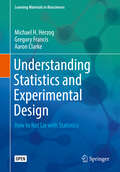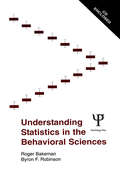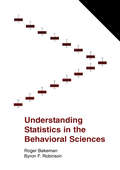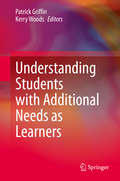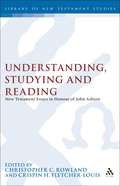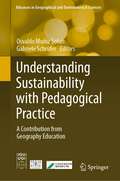- Table View
- List View
Understanding Special Educational Needs and Disability in the Early Years: Principles and Perspectives
by Janice Wearmouth Abigail Gosling Julie Beams Stephanie DavydaitisThis key text provides essential tools for understanding legislation, policy, provision and practice for children in the early years, particularly young children with special educational needs and disability (SEND). Based on extensive research and the four areas of need as defined in the Special Educational Needs and Disability Code of Practice: 0 to 25 Years (DfE, 2015), the book charts the development of young children and their growing constructions of learning, communication, language, motor movement and emotion.Providing material that translates into practice in a straightforward and practical way, this text is packed full of personal accounts and case studies, enabling readers to appreciate what the experience of SEND in the early years means for families and professionals, and also to learn more about how they might understand and respond appropriately to a child’s needs. Understanding Special Educational Needs and Disability in the Early Years will be of interest to students studying Early Years courses, families, SENDCOs, teachers and other staff supporting young children with a range of special educational needs and disabilities.
Understanding Spelling
by Olivia O'Sullivan Anne ThomasHow do children learn to spell and what kinds of teaching support them most effectively? Based on a three-year longitudinal study of children's spelling in different primary classrooms, Olivia O'Sullivan, Assistant Director of the Centre for Literacy in Primary Education and Anne Thomas, the former Inset Director of the Centre for Literacy in Primary Education, pose a number of important questions: what kinds of knowledge are involved in spelling? what are the links between learning to read and learning to spell? what kinds of systematic teaching and interventions make a difference to children's progress? Packed with case studies, photographs and examples of children’s work, this unique book sets out the most effective approaches to spelling and provides teachers with a broad set of principles on which to base their teaching. This is an invaluable resource for any teacher or trainee teacher wishing to raise standards in spelling in their classroom.
Understanding Spelling
by Olivia O'Sullivan Anne ThomasHow do children learn to spell and what kinds of teaching support them most effectively? Based on a three-year longitudinal study of children's spelling in different primary classrooms, Olivia O'Sullivan, Assistant Director of the Centre for Literacy in Primary Education and Anne Thomas, the former Inset Director of the Centre for Literacy in Primary Education, pose a number of important questions: what kinds of knowledge are involved in spelling? what are the links between learning to read and learning to spell? what kinds of systematic teaching and interventions make a difference to children's progress? Packed with case studies, photographs and examples of children’s work, this unique book sets out the most effective approaches to spelling and provides teachers with a broad set of principles on which to base their teaching. This is an invaluable resource for any teacher or trainee teacher wishing to raise standards in spelling in their classroom.
Understanding Statistics and Experimental Design: How to Not Lie with Statistics (Learning Materials in Biosciences)
by Michael H. Herzog Gregory Francis Aaron ClarkeThis open access textbook provides the background needed to correctly use, interpret and understand statistics and statistical data in diverse settings. Part I makes key concepts in statistics readily clear. Parts I and II give an overview of the most common tests (t-test, ANOVA, correlations) and work out their statistical principles. Part III provides insight into meta-statistics (statistics of statistics) and demonstrates why experiments often do not replicate. Finally, the textbook shows how complex statistics can be avoided by using clever experimental design. Both non-scientists and students in Biology, Biomedicine and Engineering will benefit from the book by learning the statistical basis of scientific claims and by discovering ways to evaluate the quality of scientific reports in academic journals and news outlets.
Understanding Statistics in the Behavioral Sciences
by Roger Bakeman Byron F. RobinsonUnderstanding Statistics in the Behavioral Sciences is designed to help readers understand research reports, analyze data, and familiarize themselves with the conceptual underpinnings of statistical analyses used in behavioral science literature. The authors review statistics in a way that is intended to reduce anxiety for students who feel intimidated by statistics. Conceptual underpinnings and practical applications are stressed, whereas algebraic derivations and complex formulas are reduced. New ideas are presented in the context of a few recurring examples, which allows readers to focus more on the new statistical concepts than on the details of different studies.The authors' selection and organization of topics is slightly different from the ordinary introductory textbook. It is motivated by the needs of a behavioral science student, or someone in clinical practice, rather than by formal, mathematical properties. The book begins with hypothesis testing and then considers how hypothesis testing is used in conjunction with statistical designs and tests to answer research questions. In addition, this book treats analysis of variance as another application of multiple regression. With this integrated, unified approach, students simultaneously learn about multiple regression and how to analyze data associated with basic analysis of variance and covariance designs. Students confront fewer topics but those they do encounter possess considerable more power, generality, and practical importance. This integrated approach helps to simplify topics that often cause confusion.Understanding Statistics in the Behavioral Sciences features:*Computer-based exercises, many of which rely on spreadsheets, help the reader perform statistical analyses and compare and verify the results using either SPSS or SAS. These exercises also provide an opportunity to explore definitional formulas by altering raw data or terms within a formula and immediately see the consequences thus providing a deeper understanding of the basic concepts.*Key terms and symbols are boxed when first introduced and repeated in a glossary to make them easier to find at review time.*Numerous tables and graphs, including spreadsheet printouts and figures, help students visualize the most critical concepts.This book is intended as a text for introductory behavioral science statistics. It will appeal to instructors who want a relatively brief text. The book's active approach to learning, works well both in the classroom and for individual self-study.
Understanding Statistics in the Behavioral Sciences
by Roger Bakeman Byron F. RobinsonUnderstanding Statistics in the Behavioral Sciences is designed to help readers understand research reports, analyze data, and familiarize themselves with the conceptual underpinnings of statistical analyses used in behavioral science literature. The authors review statistics in a way that is intended to reduce anxiety for students who feel intimidated by statistics. Conceptual underpinnings and practical applications are stressed, whereas algebraic derivations and complex formulas are reduced. New ideas are presented in the context of a few recurring examples, which allows readers to focus more on the new statistical concepts than on the details of different studies.The authors' selection and organization of topics is slightly different from the ordinary introductory textbook. It is motivated by the needs of a behavioral science student, or someone in clinical practice, rather than by formal, mathematical properties. The book begins with hypothesis testing and then considers how hypothesis testing is used in conjunction with statistical designs and tests to answer research questions. In addition, this book treats analysis of variance as another application of multiple regression. With this integrated, unified approach, students simultaneously learn about multiple regression and how to analyze data associated with basic analysis of variance and covariance designs. Students confront fewer topics but those they do encounter possess considerable more power, generality, and practical importance. This integrated approach helps to simplify topics that often cause confusion.Understanding Statistics in the Behavioral Sciences features:*Computer-based exercises, many of which rely on spreadsheets, help the reader perform statistical analyses and compare and verify the results using either SPSS or SAS. These exercises also provide an opportunity to explore definitional formulas by altering raw data or terms within a formula and immediately see the consequences thus providing a deeper understanding of the basic concepts.*Key terms and symbols are boxed when first introduced and repeated in a glossary to make them easier to find at review time.*Numerous tables and graphs, including spreadsheet printouts and figures, help students visualize the most critical concepts.This book is intended as a text for introductory behavioral science statistics. It will appeal to instructors who want a relatively brief text. The book's active approach to learning, works well both in the classroom and for individual self-study.
Understanding Storytelling Among African American Children: A Journey From Africa To America
by Tempii B. ChampionUnderstanding Storytelling Among African American Children: A Journey From Africa to America reports research on narrative production among African American children for the purpose of extending previous inquiry and discussion of narrative structure. Some researchers have focused on the influence of culture on the narrative structures employed by African American children; some have suggested that their narrative structures are strongly influenced by home culture; others posit that African American children, like children in general, produce narrative structures typically found in school settings. Dr. Champion contributes to previous research by suggesting that African American children do not produce one structure of narratives exclusively, but rather a repertoire of structures, some linked to African and African American, and others to European American narrative structures. Detailed analyses of narratives using both psychological text analysis and qualitative analysis are presented. An informative introduction provides background for the study, including a history of storytelling within the African American community. Part I offers a framework for understanding narrative structures among African American children. In Part II, evidence is presented that African American children produce a repertoire of narrative structures that are complex in nature. Part III connects the research findings to implications for educating African American children. Researchers, students, and professionals in the fields of literacy education, language development, African American studies, and communication sciences and disorders will find this book particularly relevant and useful.
Understanding Storytelling Among African American Children: A Journey From Africa To America
by Tempii B. ChampionUnderstanding Storytelling Among African American Children: A Journey From Africa to America reports research on narrative production among African American children for the purpose of extending previous inquiry and discussion of narrative structure. Some researchers have focused on the influence of culture on the narrative structures employed by African American children; some have suggested that their narrative structures are strongly influenced by home culture; others posit that African American children, like children in general, produce narrative structures typically found in school settings. Dr. Champion contributes to previous research by suggesting that African American children do not produce one structure of narratives exclusively, but rather a repertoire of structures, some linked to African and African American, and others to European American narrative structures. Detailed analyses of narratives using both psychological text analysis and qualitative analysis are presented. An informative introduction provides background for the study, including a history of storytelling within the African American community. Part I offers a framework for understanding narrative structures among African American children. In Part II, evidence is presented that African American children produce a repertoire of narrative structures that are complex in nature. Part III connects the research findings to implications for educating African American children. Researchers, students, and professionals in the fields of literacy education, language development, African American studies, and communication sciences and disorders will find this book particularly relevant and useful.
Understanding Student Learning: A Research Perspective With Implications For Teaching (Routledge Revivals)
by Noel Entwistle Paul RamsdenFirst published in 1983, Understanding Student Learning provides an in-depth analysis of students’ learning methods in higher education, at the time. It examines the extent to which these learning methods reflected the teaching, assessment and individual personalities of the students involved. The book contains interviews with students, experiments and statistical analyses of survey data in order to identify successes and difficulties in student learning and the culmination of these techniques is a clearer insight into the process of student learning.
Understanding Student Learning (Routledge Revivals)
by Noel Entwistle Paul RamsdenFirst published in 1983, Understanding Student Learning provides an in-depth analysis of students’ learning methods in higher education, at the time. It examines the extent to which these learning methods reflected the teaching, assessment and individual personalities of the students involved. The book contains interviews with students, experiments and statistical analyses of survey data in order to identify successes and difficulties in student learning and the culmination of these techniques is a clearer insight into the process of student learning.
Understanding Student Mobility in Europe: An Interdisciplinary Approach (Internationalization in Higher Education Series)
by Joana AlmeidaUnderstanding Student Mobility in Europe interprets student mobility in European higher education through an active dialogue between disciplines, voices and variables of interest. Providing the conceptual, methodological, pedagogical and empirical foundations, this book advances readers’ understanding of the student exchange experience, whilst outlining guidelines and resources for approaching student mobility and considering how students can gain from cross-border education. Intersecting voices from different disciplines and sojourners, including exchange students, international students and highly skilled immigrants, the book outlines practical guidelines for intercultural curriculum development and assessment, and provides insights, practical ideas, useful terminology and resources to maximise the learning gains of this student population. Split into three distinct parts, the book initially lays the foundational substructure in which an interdisciplinary approach is based. It then addresses questions of practical application by considering the experiences of 50 sojourners in Portugal and the UK through an interdisciplinary lens, and summarises the implications of interdisciplinarity with regards to student mobility in European tertiary-level education. This book is essential reading for academics and postgraduate students interested in student mobility, education abroad practitioners, and policy-makers at institutional, national and international levels.
Understanding Student Mobility in Europe: An Interdisciplinary Approach (Internationalization in Higher Education Series)
by Joana AlmeidaUnderstanding Student Mobility in Europe interprets student mobility in European higher education through an active dialogue between disciplines, voices and variables of interest. Providing the conceptual, methodological, pedagogical and empirical foundations, this book advances readers’ understanding of the student exchange experience, whilst outlining guidelines and resources for approaching student mobility and considering how students can gain from cross-border education. Intersecting voices from different disciplines and sojourners, including exchange students, international students and highly skilled immigrants, the book outlines practical guidelines for intercultural curriculum development and assessment, and provides insights, practical ideas, useful terminology and resources to maximise the learning gains of this student population. Split into three distinct parts, the book initially lays the foundational substructure in which an interdisciplinary approach is based. It then addresses questions of practical application by considering the experiences of 50 sojourners in Portugal and the UK through an interdisciplinary lens, and summarises the implications of interdisciplinarity with regards to student mobility in European tertiary-level education. This book is essential reading for academics and postgraduate students interested in student mobility, education abroad practitioners, and policy-makers at institutional, national and international levels.
Understanding Student Participation and Choice in Science and Technology Education
by Ellen Karoline Henriksen Justin Dillon Jim RyderDrawing on data generated by the EU’s Interests and Recruitment in Science (IRIS) project, this volume examines the issue of young people’s participation in science, technology, engineering and mathematics education. With an especial focus on female participation, the chapters offer analysis deploying varied theoretical frameworks, including sociology, social psychology and gender studies. The material also includes reviews of relevant research in science education and summaries of empirical data concerning student choices in STEM disciplines in five European countries.Featuring both quantitative and qualitative analyses, the book makes a substantial contribution to the developing theoretical agenda in STEM education. It augments available empirical data and identifies strategies in policy-making that could lead to improved participation—and gender balance—in STEM disciplines. The majority of the chapter authors are IRIS project members, with additional chapters written by specially invited contributors. The book provides researchers and policy makers alike with a comprehensive and authoritative exploration of the core issues in STEM educational participation.
Understanding Students with Additional Needs as Learners
by Patrick Griffin Kerry WoodsThis book brings together a compendium of the collaborative research from eight PhD students and three researchers, addressing an existing problem for teachers of students with additional learning needs in mainstream classes. The purpose of this research is to describe the development of growth progressions in communication and literacy, interpersonal skills and understanding of emotions, learning skills, numeracy, movement, digital literacy, thinking and problem-solving skills among students with additional needs in the classroom, known as SWANS (Students with Additional Needs). The research has grown over a decade or more and this volume brings all that research together under a single cover in a way that has not been done before. It shows how work conducted at the same system and school level that led to the design of curriculum support for SWANS, drawing on the research to establish expected learning progressions, was linked to a mainstream curriculum. It also illustrates strategies and materials that could be used by mainstream teachers or special education teachers to make teaching SWANS practical and effective. The book offers new insights, and a ready to use volume of material for curriculum writers, student teachers, researchers, and special education teachers and administrators.
Understanding, Studying and Reading: New Testament Essays in Honour of John Ashton (The Library of New Testament Studies #153)
by Christopher Rowland Crispin H. Fletcher-LouisThis collection of essays, largely written by members of the Oxford theological community, was presented to John Ashton on his 65th birthday in 1996. The essays deal with Elijah in Mark, a Q passion narrative, the Gospel thief saying, John's Beloved Disciple, the temple incident (Jn 2.13-25) and history and theology. Outside of the Gospels, they discuss God's wrath in Romans 1, Philippians 1.1-11, Hebrews 4.13, Peter and Paul behind Revelation, and hermeneutical method. Specialists from outside the New Testament field contribute studies of the patristic doctrine of Scripture, the Syriac Diatessaron, William Tyndale, the theology of the resurrection and the Byzantine understanding of John. John Ashton was, before his retirement, Lecturer in New Testament and Fellow of Wolfson College, Oxford.
Understanding Subject Knowledge for Primary Teaching (Exploring the Primary Curriculum)
by Deborah PopeHow can trainee teachers begin their careers with a clear understanding of all the curriculum subjects? This book addresses the nature of subject knowledge in all foundation curriculum subjects. It deconstructs the elements of each subject through an exploration of the nature of the subject, a coverage of the 'skills' a study of this subject develops and through detailed analysis of case studies from practice. At a time when concerns about the lack of breadth in the primary curriculum are being voiced, this book supports busy trainee teachers to truly understand and be ready to teach all curriculum areas.
Understanding Subject Knowledge for Primary Teaching (Exploring the Primary Curriculum)
by Deborah PopeHow can trainee teachers begin their careers with a clear understanding of all the curriculum subjects? This book addresses the nature of subject knowledge in all foundation curriculum subjects. It deconstructs the elements of each subject through an exploration of the nature of the subject, a coverage of the 'skills' a study of this subject develops and through detailed analysis of case studies from practice. At a time when concerns about the lack of breadth in the primary curriculum are being voiced, this book supports busy trainee teachers to truly understand and be ready to teach all curriculum areas.
Understanding Suffering in Schools: Shining a Light on the Dark Places of Education
by Joseph Polizzi William C. FrickDrawing inspiration from Dr. Willi Schohaus’s classic text The Dark Places of Education, this book contributes to the discussion by defining suffering in schools and providing a survey of the American school system’s inadequacies in the early twenty-first century. Through testimonies from former students on the ways they experienced suffering in school, this volume demonstrates how suffering can profoundly affect one’s academic growth and development—or worse. By analyzing the findings within a multidisciplinary ethical and educational framework, this volume presents a moral vision for understanding the role that suffering plays in school. Drawing on research in medicine, psychology, social sciences, religion, and education, this text weaves together many strands of thinking about suffering. This book is essential reading for academics, researchers, and postgraduate students in the fields of educational leadership, foundations of education, and those interested in both the history of education and critical contemporary accounts of schooling.
Understanding Suffering in Schools: Shining a Light on the Dark Places of Education
by Joseph Polizzi William C. FrickDrawing inspiration from Dr. Willi Schohaus’s classic text The Dark Places of Education, this book contributes to the discussion by defining suffering in schools and providing a survey of the American school system’s inadequacies in the early twenty-first century. Through testimonies from former students on the ways they experienced suffering in school, this volume demonstrates how suffering can profoundly affect one’s academic growth and development—or worse. By analyzing the findings within a multidisciplinary ethical and educational framework, this volume presents a moral vision for understanding the role that suffering plays in school. Drawing on research in medicine, psychology, social sciences, religion, and education, this text weaves together many strands of thinking about suffering. This book is essential reading for academics, researchers, and postgraduate students in the fields of educational leadership, foundations of education, and those interested in both the history of education and critical contemporary accounts of schooling.
Understanding Supervision and the PhD
by Moira PeeloMoira Peelo explores the experience of supervision and the PhD, drawing on a range of key viewpoints to further understanding of this complex educational experience.
Understanding Sustainability in Early Childhood Education: Case Studies and Approaches from Across the UK
by Diane Boyd Nicky Hirst John Siraj-BlatchfordThis unique book explores research related to education for sustainability within early childhood education in the United Kingdom. Divided into the four home nations, it examines what education for sustainability looks like in practice, discusses the different application and positions of each region, and considers the contribution of early childhood education to support the Sustainable Development Goals. Each chapter considers the relevant early years framework and includes associated case studies which highlight connections between statutory guidance, policy and positive early years pedagogical practice. The authors use an education for sustainability lens to explore the critical issues and explicit and implicit links embedded in each of the curricula frameworks. Each chapter acknowledges the context of outdoor learning with discussion related to different interpretations of ecological sustainability. This exploration should help readers to consider the idea of sustainability within early childhood education. The book considers early childhood education as a distinct and valuable phase beyond the readiness for school discourse and recognises the importance of having skilful and knowledgeable adults to work with young children from birth. It offers a unique resource for students, practitioners, leaders and researchers engaged in the study of education for sustainability in early childhood and the importance of the early years for the development of life-long pro-environmental attitudes.
Understanding Sustainability in Early Childhood Education: Case Studies and Approaches from Across the UK
by Diane Boyd Nicky Hirst John Siraj-BlatchfordThis unique book explores research related to education for sustainability within early childhood education in the United Kingdom. Divided into the four home nations, it examines what education for sustainability looks like in practice, discusses the different application and positions of each region, and considers the contribution of early childhood education to support the Sustainable Development Goals. Each chapter considers the relevant early years framework and includes associated case studies which highlight connections between statutory guidance, policy and positive early years pedagogical practice. The authors use an education for sustainability lens to explore the critical issues and explicit and implicit links embedded in each of the curricula frameworks. Each chapter acknowledges the context of outdoor learning with discussion related to different interpretations of ecological sustainability. This exploration should help readers to consider the idea of sustainability within early childhood education. The book considers early childhood education as a distinct and valuable phase beyond the readiness for school discourse and recognises the importance of having skilful and knowledgeable adults to work with young children from birth. It offers a unique resource for students, practitioners, leaders and researchers engaged in the study of education for sustainability in early childhood and the importance of the early years for the development of life-long pro-environmental attitudes.
Understanding Sustainability Principles and ESG Policies: A Multidisciplinary Approach to Public and Corporate Responses to Climate Change
by Colin ReadThis textbook explores sustainability, climate change, and the corporate responsibility movement from a broad array of perspectives, including the challenges, risks, and opportunities of ESG policies, energy and environmental science, economics and philosophy, and sound public and private sector management. There is no intergenerational issue that is more pressing than the challenge of sustainability and climate change. It is a concern that will only worsen within any reader’s lifetime, especially if we fail to act. At the same time, there is growing concern among corporations arising from the Environment, Social and Governance (ESG) paradigm that includes climate risk, future profits, and stakeholder expectations. Many of our leading institutions also increasingly acknowledge a responsibility for corporate decisions since the onset of the Industrial Revolution that plays no small role in bringing us to the existential precipice of our day. This book provides necessary tools of sufficient sophistication to address complex intergenerational issues, such as global warming, economic justice and fairness, appropriate intergenerational planning, sustainable finance, corporate risk management, and governance. The book offers a vital resource for students, shareholders, sustainability practitioners, agencies, and advocates interested in climate action, intergenerational accountability, and economic sustainability.
Understanding Sustainability with Pedagogical Practice: A Contribution from Geography Education (Advances in Geographical and Environmental Sciences)
by Osvaldo Muñiz Solari Gabriele SchrüferThis book shares with an international audience of teachers, scholars, and policymakers the experience of pedagogical practices to facilitate sustainability in the world. Sustainability is seen here as a journey toward the end state of sustainable development. Therefore, the authors contribute different roads to engage teachers and students with pedagogical discourse. Overall, the book demonstrates the value of powerful knowledge through action-oriented learning based on a bottom-up process. Consequently, pedagogical practices are understood as the instructional approaches based on a social constructivist model in which active learning is performed with student-to-student engagement. Secondary teachers in social sciences and university professors in geography find the study to be a valuable source of stimulation for incorporating new ideas and resolving common problems in their learning and teaching environments. Education policymakers around the world also benefit from the only publication that presents international perspectives on geographical knowledge related to sustainability.The contributing authors are experienced scientists in the field of geography education who are giving special attention to pedagogical practices that promote new directions toward sustainable thinking.This book is the first outcome of an international collaboration officially established in 2023 between the Department of Geography and Environmental Studies at Texas State University and the Department of Geography at the University of Bayreuth.
Understanding Tablets from Early Childhood to Adulthood: Encounters with Touch Technology
by Rhonda McEwen Adam DubéUnderstanding Tablets from Early Childhood to Adulthood offers an alternative to dominant and populist narratives that young people are intuitively able to successfully use tablet devices. Adopting a research-driven approach, the book contests the ideology that touch-technologies are easier to understand, and identifies the factors that contribute to communicative encounters between users and tablets. Communication theory and cognitive psychology concepts and methods are employed to offer an epistemological exploration of user-tablet interaction with a focus on the use of these technologies in educational settings.


